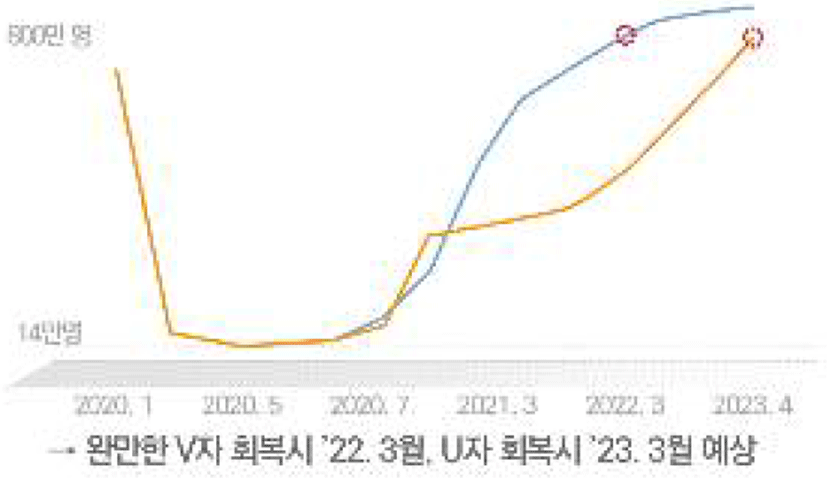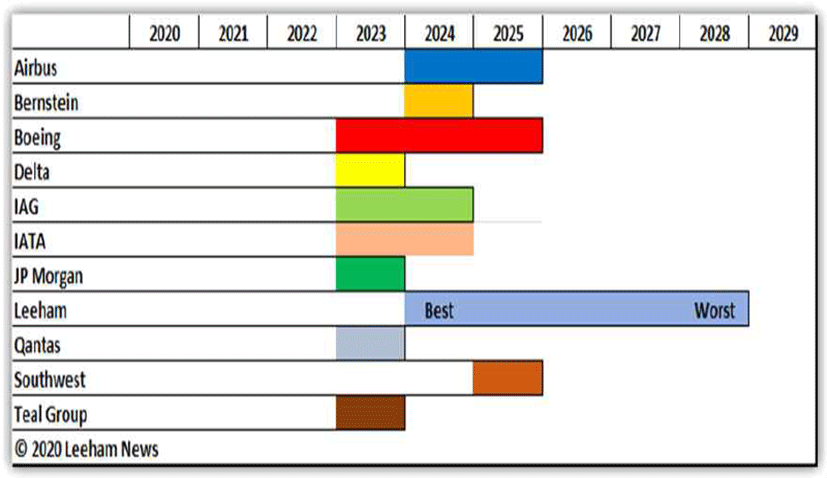I. INTRODUCTION
After several months of travel restrictions and travel bans due to the COVID-19 pandemic, the aviation industry is faced with the biggest challenges in terms of demand and revenue. Many airlines had to close their businessesand file for bankruptcy, and thousands of employees who worked in the industry were also hurt. People were afraid to travel, and many flights got canceled. Countries around the world are struggling to maintain the stability of markets in various economic sectors due to the COVID-19 pandemic, but the most affected are the aviation industry (Mustapha et al., 2020).
Passenger demand for air services of major airlines around the world, which has been hit hard over the past few months, has declined by 70-95% (Whitely et al., 2020). As of September 2020, air traffic performance in Korea showed a 96% decline in passenger demand (KCAA, 2020). Aviation experts and business executives have expressed their concern that increasing passenger confidence in health and safety will be a complex challenge to overcome in the post-Covid 19 era (Shepardson et al., 2020). According to a survey conducted by the International Air Transport Association (IATA) (June 2020), for example, 36% of respondents answered that they would wait at least 6 months until they begin to fly again in the post-Covid 19 era, while 14% of respondents said they would wait more than a year to travel by air (Rockland, 2020). Also, some argue that even if a vaccine is developed, it will take several more years for the demand for air services to return to the last year’s level because it takes time to distribute all doses and get people vaccinated (Asia Economy, 2020. 10. 30).
Aviation is a key element of tourism, and itplays an important role as a pathway to the global economic supply chain (Morrell & Klein, 2019). In most countries, there is no dispute that aviation will play an important role and function in reviving their national economies after Covid-19 (Macilree & Duval, 2020).
The purpose of this study is to analyze the prospects of the Covid-19 pandemic that is a significant threat both domestically and internationally, and changes in aviation demand while presenting the steps that the aviation industry needs to take in the future based on post-corona predictions and judgments.
II. THEORETICAL BACKGROUND
As shown in Fig. 1, a group of aviation experts predicts that the recovery period for post-Covid-19 air travel may take longer than expected, which implies that it will be necessary to pay close attention to passenger health and safety to maintain the aviation industry even in the post-Covid-19 era. Consequently, the aviation industry must take precautionary measures to ensure sustainable and fully functioning operations (Mustapha. et al., 2020).
Policies regarding face masks or disinfection procedures of aircrafts can help alleviate fears and concerns about the resumption of air travel, potentially increasing passengers’ willingness to fly and helping airlines provide clear messages to the passengers (Lamb et al., 2020). Therefore, the Covid-19 crisis must be viewed as a positive opportunity to examine the growth process of the aviation industry so far with a critical eye and to contemplate whether such growth would benefit more travelers in the future (Gössling et al., 2020).
Haldane (2020) argued that an economic crisis caused by an epidemic usually makes a rapid V-shaped economic recovery based on a result of investigating the possibilities of various economic recovery scenarios with the efficiency of national economic policies and Covid-19 quarantine measures as variables. The Ministry of Land, Infrastructure, and Transport of South Korea forecast that the recovery of passenger demand for air services rescovery of air services would appear in two patterns depending on the time of the recovery as shown in Fig. 2. The first is a gradual recovery, which is predicted to start in March 2022, and the second is a U-shaped recovery, which is expected to begin in March 2023.

III. RESEARCH METHOD
This study used the SWOT analysis to predict and prepare a strategic response to the structural changes in the aviation industry amid the approaching of the post-Covid-19 era. In order to secure the validity of the SWOT analysis, a survey with in-depth questions was conducted among a group of aviation-related experts. Ten people in Table 1. with at least 20 years of experience in the aviation industry, who are currently actively engaged in academia or airlines, were selected as the study participants. Their data were collected through in-depth interviews and questionnaires. The in-depth interview is suitable when searching for detailed information and new issues from experts(Kim et al., 2014). This study constructed a total of 5 questions for SWOT (strengths, weaknesses, opportunities, and threats) analysis of the impact of the Covid-19 pandemic on passenger demand for air services.
This study collected data using in-depth interviews and questionnaires to examine the impact of the Corona 19 pandemic on air travel demand. It also reconstructed content used in the questionnaire based on previous studies by Kim and Park (2018) and Song and Kim (2020). The range of interview content organized to analyze the experts’ perceptions is the same as in Table 2.
This study used the interview method of James Spradley(1980). Each theme was divided into sub-sections, and the contents were systematically analyzed according to the order of the questions. Then, the study organized similar interview contents, and analyzed and derived the outcomes.
IV. RESULTS AND DISCUSSION
Passengers are airlines’ main source of income, whereas cargo is the secondary source of income (Wells, 2007). Most airlines need at least a 67% passenger occupancy rate to maintain the breakeven point (Sinha, 2019). Today’s aviation industry, however, is preparing for another change due to Covid-19. There is an increased desire for the spread of touchless travel and the health and safety of the passenger in the use of aircraft. The results derived by applying SWOT analysis centered on experts to forecast passenger demand amid these changing trends are as follows.
The aviation industry is constantly seeking ways to generate revenue amid the Covid-19 crisis. The industry is considering applying the new normal phenomenon that has emerged based on no-touch and non-face-to-face daily life to the aviation industry in order to increase air travel demand.
As the prolonged deterioration of airline businesses due to Covid-19 led to the restructuring of the industry, a change began to take place in the airline market that used to be overly competitive and worryingly heated. Moreover, airlines began to focus on gaining customer confidence and trust by improving the quarantine measures at airports and of airlines to block the spread of Covid-19.
-
- Despite the prolonged outbreak of the Covid-19, the domestic market is returning to last year’s level. (Participant 1)
-
- Based on the experience in the domestic market, the airlines are becoming increasingly confident in their in-flight quarantine measures for international flights. (Participant 10)
As the global economy is intertwined with the complex supply and demand chains around the world, the Covid-19 pandemic is affecting every country due to the collapse of the global production and consumption system (Barro et al., 2020). Above all, as the global production and distribution system collapse and the increasing number of businesses discontinue their production lines, the pandemic is leading to a decline in jobs. Among them, airlines are suffering from the most serious business blow.
-
- As the business difficulties of airlines become worse over time, there are concerns that in the worst-case scenario, they could be pushed to large-scale restructuring. (Participant 7, 10)
-
- There are more than 40 airlines worldwide that have gone bankrupt or have ceased operations due to Covid-19. (Participant 6)
There is a forecast that the spread and replacement of teleworking due to Covid-19 may pose a risk to air travel demand. In addition, there is a limitation in seating arrangement due to new normal such as social distancing.
-
- Overseas business trips will be reduced due to the spread of video conferencing technology and telecommuting of business passengers that are major consumers of airline passenger demand. (Participant 4)
-
- Employers will prohibit employees from moving to areas affected by COVID-19. This will have a negative effect on airlines’ high value-added reservations. (Participant 10)
-
- The priority of airlines is to lower prices enough to fill the aircraft that is currently in operation (Participant 3, 8)
-
- Airlines have a dilemma because if they vacate the seats in the middle for onboard social-distancing, they will have to increase the flight prices. (Participant 9)
-
- Social distancing will become a new normal even inside the plane. Passengers will want more premium seats with a wider space, which will result in a natural increase in the airfares. (Participant 5)
With the prolonged Covid-19 outbreak, the attitude to overcome the current situation has become all the more important, requiring a new perspective for management improvement. It has become crucial to predict positive results and view the change in air travel trend caused by Covid-19 as an opportunity factor.
V. CONCLUSION
This study investigated the crisis in the aviation industry brought about by the Covid-19 pandemic and conducted SWOT analysis on air travel demand through the lenses of experts’ views. According to the results of the SWOT analysis conducted among 10 aviation experts, first, the continuation of the non-face-to-face culture and the resulting changes in air travel were predicted.
Second, as for the factors strengthening air travel demand, the aviation market that used to be overheated will revive through the reorganization and restructuring of the industry, while the sustainable implementation of safety and health measures by airlines will positively affect air travel demand by securing customer trust.
Third, factors that will weaken air travel demand were found to be negative economic growth due to prolonged Covid-19 outbreak and restructuring of airlines.
Fourth, factors threatening air travel demand were the spread of teleworking and an increase in flight prices.
Fifth, as an opportunity factor for air travel demand, the non-face-to-face digital environment will be accelerated, while the consumer rights in flight ticket fees will be increased.
The policy implications the aviation industry can apply through the SWOT analysis results are as follows. First, with the advent of the post-Covid-19 era, the recovery of air travel demand depends on securing customer trust in health and safety first and foremost. Therefore, the aviation industry must prepare to secure the level of air travel demand before Covid-19, placing the highest priority on customer trust with reliable quarantine efforts. Second, the airline industry must consider introducing reasonable air prices. In the post-Covid-19 era, where travel restrictions will be lifted, airlines must introduce a price policy that will be attractive to customers to make them want to travel by air again, thereby, increasing the air travel demand. The airline's reasonable pricing policy will have a positive effect on increasing the air travel demand, in the long run, creating a win-win situation for customers whose incomes have dropped due to the economic recession.

